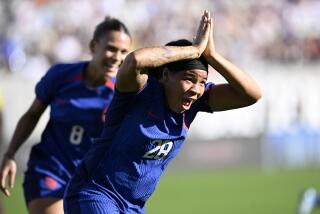Getting a leg up
- Share via
An athlete crumples to the ground untouched, yelling in pain and grabbing her knee. It’s a scene that plays out daily on soccer fields, basketball courts and volleyball courts.
In 2011, Maddie Tantillo, a 29-year-old semi-pro soccer player for the San Diego Sea Lions, was making a move she’d made countless times before -- planting with her left leg before running right -- when her left knee buckled. “Everyone said I’d be fine,” but an MRI showed otherwise. “I had torn my ACL.”
The ACL -- the anterior cruciate ligament that connects the kneecap to the tibia -- tears remarkably easily. Every year, about a quarter of a million Americans undergo surgery to repair the ligament.
For all of the talk about torn ACLs in the NFL or NBA, Tantillo could be the real face of the injury. Female athletes are nearly four times more likely than males to tear their ACLs. “So many women and girls are playing sports these days,” says Dr. Natalie Voskanian, assistant clinical professor of sports medicine at UC San Diego. “This injury can end their season, and it can end their [participation in a] sport.”
The rash of torn ACLs has inspired researchers around the world to take a closer look at the knee and the anatomy of the injury. After working with many thousands of young athletes and watching countless hours of game video, experts have made discoveries that can protect all athletes, male and female, professional and amateur. “These are devastating injuries with severe, long-lasting consequences,” says Timothy Hewett, director of research for sports medicine at Ohio State University. “We need to prevent every ACL injury that we can.”
Hewett has studied enough videos to know the classic scenario: After a jump or sudden stop, a player lands on one leg with a flat foot and a straight knee. The knee starts caving inward while the foot is still planted to the ground, creating a violent torque that can snap the ACL. About 70% of ACL tears happen without any contact with a player.
To clear up a couple of common myths: It’s not “wide hips” or hormones that make women and girls so prone to knee injuries. Instead, Hewett says, the injuries seem to be linked to bad habits and strength imbalances that are especially common in female athletes. By correcting these flaws through targeted exercises and training, athletes of either gender can protect their knees and greatly improve their chances to stay in the game.
For starters, many athletes -- male and female -- need to learn how to land “softly,” Hewett says. That means landing on the ball of the foot with the knee slightly flexed. “ACLs don’t tear when the knee is flexed,” he says.
Bad habits can be unlearned, but that’s just the start. Hewett says many athletes also have to address dangerous weak spots. For example, female athletes often need to strengthen the hamstring muscles on the back of the thigh. Hewett has found that women and girls with weak hamstring muscles often compensate with their quadriceps muscles when they jump or make sudden moves. That’s risky because the quad muscles stiffen the knee and pull the tibia forward while the ACL tries to hold it back, an internal tug of war that can strain the ACL.
Armed with a better understanding of the root causes of knee injuries, Hewett and others have developed training programs specifically designed to protect the ACL. And the efforts have definitely paid off. A 2012 study by Hewett and colleagues published in the British Journal of Sports Medicine combined the results of 12 attempts to prevent knee injuries in female athletes. Overall, women and girls who participated in the programs were about 70% less likely to suffer a non-contact ACL injury.
In a recent experiment in Sweden, teenage girls from 49 soccer teams went through a nine-month regimen designed to improve balance, stability and knee strength. An additional 48 soccer teams didn’t get any extra training. Overall, only three girls who went through the training suffered knee injuries that season, compared with 13 girls from teams that didn’t.
As the Swedish study shows, it takes lot of work to prevent a handful of injuries. Hewett’s own study estimated that more than 100 female athletes would have to undergo extensive training to prevent one non-contact ACL injury.
Voskanian adds that training could be much more effective if coaches and trainers could target the athletes who are most likely to suffer knee injuries.
The exercises do far more than just protect the knees, she says. “They improve fitness, agility, balance and strength.” In certain circles, those benefits might be the real selling point. “Some coaches aren’t as interested in injury prevention as they are in performance.”
Of course, women who play recreational basketball, volleyball or soccer generally don’t have a personal trainer or coach. But they can still try a training program on their own. Voskanian recommends the online PEP (Prevent Injury and Enhance Performance) program -- including videos and training tips -- offered by the Santa Monica Sports Medicine Foundation (smsmf.org).
Tantillo, who was sidelined for seven months by her injury, is already doing what she can to prevent ACL tears. “I think more about my moves. I’m a little more conscious about how I land or plant my foot.” But Tantillo isn’t just a player. She’s also a college and high school coach, which means she has a chance to save other players the pain that she went through. “I use an ACL prevention warm-up, and they know how to cut properly and how to land.”
--
--
(BEGIN TEXT OF INFOBOX)
--
How to tell if your knees are at risk
Natalie Voskanian says that any athlete can easily check his or her risk for knee injury with some simple tests developed by Sportmetrics, a nationwide anterior cruciate ligament (ACL) injury prevention program. Professional trainers often administer such tests in a gym, but, Voskanian says, “You can also do them by yourself with a mirror.”
You can see a demonstration of these tests on YouTube or at the Sportsmetrics website, sportsmetrics.org/knee-injury-test.
Drop-jump test: Jump from a stable surface about 24 inches off the ground, land with both feet and immediately jump straight up again. If your knees cave in during either landing, you may be at extra risk for a knee injury.
Triple-hop stability test: Take three hops forward on one leg, and try to hold the final landing for five seconds. If you struggle to stay upright, you may need balance and strength training.
Single-leg squat test: Standing straight on one leg with your hands on your hips, bend your other leg to form a 90-degree angle at the knee. Squat down as low as possible five times, and then switch legs. If you have trouble keeping your balance, your knees could be in danger.
--
Chris Woolston
More to Read
Go beyond the scoreboard
Get the latest on L.A.'s teams in the daily Sports Report newsletter.
You may occasionally receive promotional content from the Los Angeles Times.










